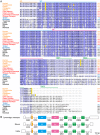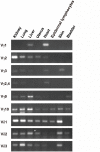The SKINT1-like gene is inactivated in hominoids but not in all primate species: implications for the origin of dendritic epidermal T cells
- PMID: 25830554
- PMCID: PMC4382165
- DOI: 10.1371/journal.pone.0123258
The SKINT1-like gene is inactivated in hominoids but not in all primate species: implications for the origin of dendritic epidermal T cells
Abstract
Dendritic epidermal T cells, which express an invariant Vγ5Vδ1 T-cell receptor and account for 95% of all resident T cells in the mouse epidermis, play a critical role in skin immune surveillance. These γδ T cells are generated by positive selection in the fetal thymus, after which they migrate to the skin. The development of dendritic epidermal T cells is critically dependent on the Skint1 gene expressed specifically in keratinocytes and thymic epithelial cells, suggesting an indispensable role for Skint1 in the selection machinery for specific intraepithelial lymphocytes. Phylogenetically, rodents have functional SKINT1 molecules, but humans and chimpanzees have a SKINT1-like (SKINT1L) gene with multiple inactivating mutations. In the present study, we analyzed SKINT1L sequences in representative primate species and found that all hominoid species have a common inactivating mutation, but that Old World monkeys such as olive baboons, green monkeys, cynomolgus macaques and rhesus macaques have apparently functional SKINT1L sequences, indicating that SKINT1L was inactivated in a common ancestor of hominoids. Interestingly, the epidermis of cynomolgus macaques contained a population of dendritic-shaped γδ T cells expressing a semi-invariant Vγ10/Vδ1 T-cell receptor. However, this population of macaque T cells differed from rodent dendritic epidermal T cells in that their Vγ10/Vδ1 T-cell receptors displayed junctional diversity and expression of Vγ10 was not epidermis-specific. Therefore, macaques do not appear to have rodent-type dendritic epidermal T cells despite having apparently functional SKINT1L. Comprehensive bioinformatics analysis indicates that SKINT1L emerged in an ancestor of placental mammals but was inactivated or lost multiple times in mammalian evolution and that Skint1 arose by gene duplication in a rodent lineage, suggesting that authentic dendritic epidermal T cells are presumably unique to rodents.
Conflict of interest statement
Figures






Similar articles
-
Origin and Evolution of Dendritic Epidermal T Cells.Front Immunol. 2018 May 14;9:1059. doi: 10.3389/fimmu.2018.01059. eCollection 2018. Front Immunol. 2018. PMID: 29868019 Free PMC article. Review.
-
The Vγ9Vδ2 T Cell Antigen Receptor and Butyrophilin-3 A1: Models of Interaction, the Possibility of Co-Evolution, and the Case of Dendritic Epidermal T Cells.Front Immunol. 2014 Dec 19;5:648. doi: 10.3389/fimmu.2014.00648. eCollection 2014. Front Immunol. 2014. PMID: 25566259 Free PMC article. Review.
-
Skint1, the prototype of a newly identified immunoglobulin superfamily gene cluster, positively selects epidermal gammadelta T cells.Nat Genet. 2008 May;40(5):656-62. doi: 10.1038/ng.108. Epub 2008 Apr 13. Nat Genet. 2008. PMID: 18408721 Free PMC article.
-
Characterization of two mannose-binding protein cDNAs from rhesus monkey (Macaca mulatta): structure and evolutionary implications.Glycobiology. 1996 Jul;6(5):543-50. doi: 10.1093/glycob/6.5.543. Glycobiology. 1996. PMID: 8877375
-
Characterization of the major histocompatibility complex class I A alleles in cynomolgus macaques of Vietnamese origin.Tissue Antigens. 2012 Dec;80(6):494-501. doi: 10.1111/tan.12024. Tissue Antigens. 2012. PMID: 23137320
Cited by
-
Integrating gene annotation with orthology inference at scale.Science. 2023 Apr 28;380(6643):eabn3107. doi: 10.1126/science.abn3107. Epub 2023 Apr 28. Science. 2023. PMID: 37104600 Free PMC article.
-
Functional Phenotypes of Human Vγ9Vδ2 T Cells in Lymphoid Stress Surveillance.Cells. 2020 Mar 22;9(3):772. doi: 10.3390/cells9030772. Cells. 2020. PMID: 32235722 Free PMC article. Review.
-
International Harmonization of Nomenclature and Diagnostic Criteria (INHAND): Non-proliferative and Proliferative Lesions of the Non-human Primate (M. fascicularis).J Toxicol Pathol. 2021;34(3 Suppl):1S-182S. doi: 10.1293/tox.34.1S. Epub 2021 Sep 28. J Toxicol Pathol. 2021. PMID: 34712008 Free PMC article. Review.
-
A γδ T cell-IL-3 axis controls allergic responses through sensory neurons.Nature. 2024 Oct;634(8033):440-446. doi: 10.1038/s41586-024-07869-0. Epub 2024 Sep 4. Nature. 2024. PMID: 39232162 Free PMC article.
-
The emerging role of γδ T cells in cancer immunotherapy.Immunooncol Technol. 2019 Jun 26;1:3-10. doi: 10.1016/j.iotech.2019.06.002. eCollection 2019 Jul. Immunooncol Technol. 2019. PMID: 35755322 Free PMC article. Review.
References
-
- Allison JP, Havran WL. The immunobiology of T cells with invariant γδ antigen receptors. Annu Rev Immunol. 1991; 9: 679–705. - PubMed
-
- Hayday AC. γδ cells: a right time and a right place for a conserved third way of protection. Annu Rev Immunol. 2000; 18: 975–1026. - PubMed
-
- Itohara S, Farr AG, Lafaille JJ, Bonneville M, Takagaki Y, Haas W, et al. Homing of a γδ thymocyte subset with homogeneous T-cell receptors to mucosal epithelia. Nature. 1990; 343: 754–757. - PubMed
Publication types
MeSH terms
Associated data
- Actions
LinkOut - more resources
Full Text Sources
Other Literature Sources
Molecular Biology Databases

